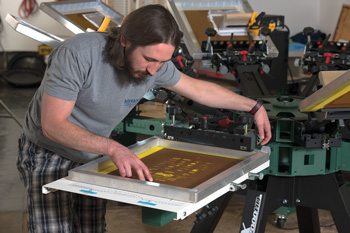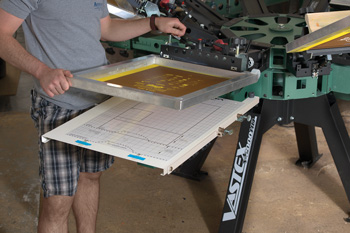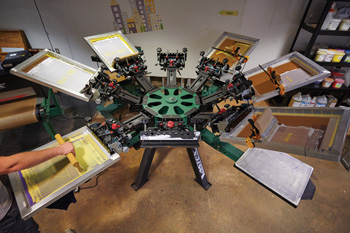JEFFERSONVILLE, PA — Rubber stamps have been the mainstay of Advance Stamp & Sign Co. since Bernie Sitron opened his doors three generations and 60-plus years ago. The family business has since expanded to include engraved signs and notary seals, large format printing, vehicle lettering, architectural signs and — most recently — screen printing for garments and Coroplast® signs.
"To this day, we still make rubber stamps all day long," says general manager and Bernie's grandson, Elliot Sitron, who joined the company in 2005. Once on board, he began investing in automation to reduce labor and improve efficiency. Upgrades included a laser cutter and engraver for making rubber stamps and a rotary engraver/router for producing Braille signage.
With the advent of high-tech equipment, the shop was able to fill larger orders while keeping all services in-house-with the exception of printed garments.
"Every now and then someone would request a printed T-shirt or hoodie," says Sitron. "We hate to say no to a customer, so we'd outsource the work. But we lacked control over quality and turnaround time."
Interchangeable pallets and conveyor dryer accommodate diverse substrates
He began researching screen printing for garments and discovered that the process could also make a cost-effective alternative to vinyl cutting, the shop's standard method for producing Coroplast signs.
In 2018, he purchased the necessary pre-press and printing equipment from Vastex International of Bethlehem, PA. Thereafter, he and one of his employees attended a three-day Vastex training course to learn the screen printing process.
With its new 4 color/4 station V-2000HD manual press, Advance Stamp & Sign began printing shirts and hoodies for local businesses and schools as well as signage. The press's micro-registration system allows fine-tuning of print alignment to maintain registration throughout the run. Adjustments are made with hand knobs instead of tools, which was a selling point for Sitron.
For garments, he uses a RedFlash flash cure unit with an 18 x 24 in. (46 x 61 cm) heater and an AutoFlash upgrade to flash plastisol ink between colors. The head of the unit rotates into place via a foot pedal and automatically rotates away from the pallet after a preset dwell time.
"Because we're relatively new to screen printing, it made sense to have an automatic flash cure unit," He says. "It takes a variable out of the process that could potentially be a problem: if we forget to move the flash unit, it could scorch the shirt."
Manual screen printing of Coroplast signs
Coroplast substrates can be challenging to work with, explains Sitron: the signs are made of non-porous, corrugated plastic, which does not absorb ink like the shirts do and can lead to colors bleeding.
He invested in a 20 x 26 in. (51 x 66 cm) vacuum pallet to accommodate 12 x 18 in. (30 x 46 cm) and 18 x 24 in. (46 x 61 cm) signs. The pallet mounts on a pallet arm that slides onto the rotor arm of the press, making it easy to switch pallets as needed. The vacuum pallet's leveling feature ensures an even transfer of ink while an integral vacuum pump and hundreds of perforations across a suction grid hold the substrate securely in place.
Unlike plastisol ink, which cures with heat, Coroplast substrates require a thinner, solvent-based ink that air dries.
With the manual press and vacuum pallet, operators can print a detailed sign in two to three colors-something he could not achieve with vinyl lettering due to the time and expense involved.
"We just finished screen printing 100 signs for a high school," he says. "Previously, we could only print 12 to 24 signs because making more was not cost-effective. We would have to unload and load different rolls of vinyl, which was time-consuming and far more expensive than a container of ink."
The finished signs air dry on a drying rack while printed garments dry in a LittleRed® X1 infrared conveyor dryer with a 30 in. (76 cm) wide conveyor belt. Having a 2,600-watt heater, the dryer can cure up to 130 plastisol-printed images per hour.
"The heater unit can be raised or lowered, depending on whether we're running a sweatshirt with a hood or a thin, polyester shirt," he says. "The temperature and belt speed are also adjustable, which allows you to set a higher temperature for cotton and a lower temperature for polyester to prevent the dye from migrating into the printed area."
Prepress equipment for signs or shirts
Sitron invested in a C-100 screen coater after seeing other printers struggle to coat screens without the aid of a mounted rack. The height of the rack is adjustable and can accommodate screens for garments as well as 23 x 31 in. (58 x 79 cm) screens for Coroplast signs. He says that the rack gives him greater control over the coating process and reduces the mess.
"Everything I read said that if you don't have a quality screen you won't have a quality print," so he researched exposure units and decided on an E-200-2331 unit having a 23 x 31 in. (60 x 80 cm) maximum screen outside diameter to accommodate standard as well as Coroplast screens. Exposure time is approximately one minute. He appreciates that the LED unit is energy-efficient, and that bulb changes are "almost nonexistent."
He also invested in a VRS pin registration system to locate positives onto the screen off-press. Using the alignment pin board, the positives are attached to setup sheets in register and then attached to the screens. Screens are then clamped onto the press in register using a pallet jig.
"The registration system has been a major timesaver because we can't dedicate our entire day to screen printing; we also need to make engraved signs and stamps," he explains, adding, "We can set up a four-color job, expose it, and rinse and dry the screens within 10 minutes."
He recently upgraded the company's press to eight colors/eight stations to fulfill an order for the March of Dimes. He says the retrofit required only a few hours.
While Sitron is involved in day-to-day operations, his father, Steve, who owns the company, visits existing and prospective clients to promote the screen printing side of the business.
"Screen printing is still a fraction of what we do," Elliot Sitron says, "but in time it will grow. When it does, the next machine we will need to upgrade is our dryer."
Meanwhile, he enjoys his newfound skill: "Screen printing is hands-on and offers instant gratification. It's a nice change of pace from setting up a big job on a machine and just letting it run."
Advance Stamp & Sign Co.
610-539-3000
orders@advancestamp.com
https://advancestamp.com

A foot pedal rotates the flash cure unit into place above the newly printed color, and then automatically rotates away, preventing over- or under-flashing.

Micro-registration knobs, foreground, allow precise screen adjustments.

The 30 in. (76 cm) wide infrared conveyor dryer can cure up to 130 plastisol-printed images per hour.

Advance Stamp & Sign owners Steve and Elliot Sitron


















